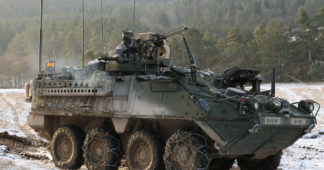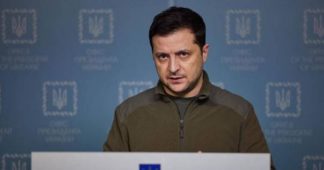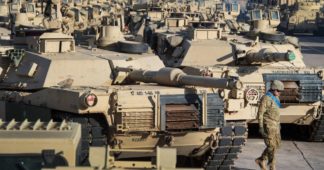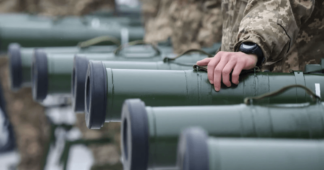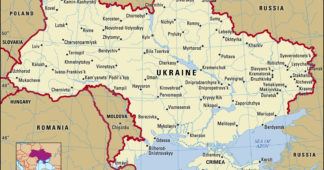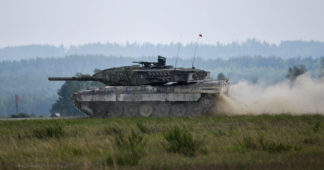Never-ending escalation will result in catastrophe
By Thomas Fazi
Feb 8, 2023
Now and then, even the most seasoned politician happens to slip up and accidently speak the truth. This is what occurred during a recent debate at the Parliamentary Assembly of the Council of Europe, when the German Foreign Minister Annalena Baerbock openly stated that “we are fighting a war against Russia”. The German government was quick to say her words had been “misinterpreted”, but the truth is that she did nothing more than say it how it is.
Almost a year into the conflict, the narrative of Western intervention in Ukraine — that “Nato is not at war with Russia” and that “the equipment we’re providing is purely defensive” — is being revealed for what it always was: a fiction. Last month, at Ramstein Air Base in Germany, another kernel of truth slipped through the cracks at a briefing by US Defense Secretary Lloyd Austin and Chairman of the Joint Chiefs of Staff General Mark Milley. Austin and Miller stated in no uncertain terms that the US was committed to going “on the offensive to liberate Russian-occupied Ukraine” — which, according to the United States, includes both the entire Donbas and Crimea.
The admission that the weapons being provided by the US and Nato are of an offensive, not defensive, character marks a significant U-turn for the Biden administration. In March last year, Biden promised the public that the US would not send “offensive equipment” and “planes and tanks” to Ukraine, because this would trigger “World War III”. Indeed, just a few months ago, the provision of tanks to Ukraine was still deemed unthinkable.
Yet in the coming months, the US is planning to deliver 31 Abrams tanks, and even Germany, after weeks of reluctance, has caved in to the immense pressure coming from Washington and other allies. The German government has agreed to send 14 of its Leopard 2 tanks to Ukraine, and has also given the go-ahead to a number of other European countries which want to send their own German-made Leopard 2 tanks. Meanwhile, the UK has committed 14 of its own tanks. In total, Ukraine is set to receive around 100 tanks, but the number is likely to go up (Zelensky has asked for 300-500).
This is simply the latest in a long list of red lines that the US and Nato have crossed since the start of the conflict. At the start of the war, the New York Times cautioned that the overt supply of even small arms and light weaponry — initial provisions were limited to rocket launchers and anti-tank and surface-to-air missiles — “risks encouraging a wider war and possible retaliation” from Russia, while US officials ruled out more advanced weaponry as too escalatory. Just two months later, the Biden administration backtracked and announced that it would in fact be sending Mi-17 helicopters, 155-mm Howitzer cannons and Switchblade “kamikaze” drones.
At that point, a new red line was drawn: despite Kyiv’s requests, the US said it would not provide Ukraine with long-range rocket systems capable of striking inside Russian territory (the M270 MLRS and the M142 HIMARS) due to concerns in Washington that this “could be seen as an escalation by the Kremlin”. It took the administration just two weeks to change its mind, on the condition that Ukraine would not use them against targets on Russian territory — until, in December, that line was crossed as well, when Ukraine hit airfields hundreds of kilometres into Russia (with the US’s approval). The about-face over the shipment of battle tanks was just as quick, as we’ve seen.
In this apparently never-ending escalation, the only question is: what’s next? Ukraine is now pushing for Western fourth-generation fighter jets, such as the US F-16s. Biden and Nato Secretary General Jens Stoltenberg have ruled this out, but there’s no reason to believe they won’t backpedal on the F-16s as well, just as they’ve done on every other self-imposed red line. The Ukrainians, for their part, seem pretty confident. As the Ukrainian Defense Minister, Oleksii Reznikov, recently stated: “When I was in DC in November [2021], before the invasion, and asked for Stingers, they told me it was impossible. Now it’s possible. When I asked for 155-millimeter guns, the answer was no. HIMARS, no. HARM [missiles], no. Now all of that is a yes. Therefore, I’m certain that tomorrow there will be…F-16s.”
We can, therefore, expect fighter jets to be on the agenda at the Nato meeting next week. Several European countries, including France, have already signalled their openness to sending fighter jets to Ukraine and, according to Politico, Ukrainian pilots could soon start training on the F-16s in the United States. In the meantime, Lockheed Martin — one of the many US defence companies making a killing thanks to the conflict — has announced that it is going to ramp up production to meet the extra demand.
Jet fighters aside, however, we need to acknowledge that we are already at war with Russia, as the German Foreign Minister inadvertently admitted. The fact that there has been no formal declaration of war is beside the point: the United States has not officially declared war since the Second World War, but this has not stopped it from intervening militarily in dozens of countries. The presence of actual American or Nato soldiers on the ground (though there have been reports of the presence of US special operations forces in Ukraine) is also, ultimately, of secondary importance. By providing increasingly powerful military equipment as well as financial, technical, logistical and training support to one of the warring factions, including for offensive operations (even within Russian territory), the West is engaged in a de facto military confrontation with Russia, regardless of what our leaders may claim.
Western citizens deserve to be told what is going on in Ukraine — and what the stakes are. Perhaps the wildest claim being made is that “if we deliver all the weapons Ukraine needs, they can win”, as former Nato Secretary General Anders Fogh Rasmussen recently asserted. For Rasmussen, and other Western hawks, this includes retaking Crimea, which Russia annexed in 2014 and which it considers of the utmost strategic importance. Many Western allies still consider this an uncrossable red line. But for how long? Just last month, the New York Times reported that the Biden administration is warming up to the idea of backing a Ukrainian offensive on Crimea.
This strategy is based on the assumption that Russia will accept a military defeat and the loss of the territories it controls without resorting to the unthinkable — the use of nuclear weapons. But this is a massive assumption on which to gamble the future of humanity, especially coming from the very Western strategists who disastrously botched every major military forecast over the past 20 years, from Iraq to Afghanistan. The truth is that, from Russia’s perspective, it is fighting against what it perceives to be an existential threat in Ukraine, and there is no reason to believe that, with its back against the wall, it won’t go to extreme measures to guarantee its survival. As Dmitry Medvedev, deputy chairman of Russia’s Security Council, put it: “The loss of a nuclear power in a conventional war can provoke the outbreak of a nuclear war. Nuclear powers do not lose major conflicts on which their fate depends.”
During the Cold War, this was widely understood by Western leaders. But today, by constantly escalating their support for Ukraine’s military, the United States and Nato appear to have forgotten it, and are instead inching closer to a catastrophic scenario. As Douglas Macgregor, the former advisor to the Secretary of Defense in the Trump administration, has written: “Neither we nor our allies are prepared to fight all-out war with Russia, regionally or globally. The point is, if war breaks out between Russia and the United States, Americans should not be surprised. The Biden administration and its bipartisan supporters in Washington are doing all they possibly can to make it happen.” According to a number of experts, a Ukrainian offensive on Crimea is one of the most likely ways this conflict could lead to nuclear warfare. Excluding a such extreme outcome, and barring a peaceful resolution to the conflict, the most likely scenario is the “Afghanistanisation” of Ukraine: a protracted conflict that could potentially last years, given that it is just as unlikely that Nato will allow Ukraine to be militarily defeated — whatever that would entail.
The simple truth, then, is that no one can “win” this war. Meanwhile, a protracted war only increases the likelihood of a direct conflict between Russia and Nato. This is now even acknowledged by the RAND corporation, the very influential and ultra-hawkish US military think tank. In a new report titled Avoiding a Long War, the authors warn against the risk of a “protracted conflict”, saying that this would lead to “a prolonged elevated risk of Russian nuclear use and a Nato-Russia war” that would seriously jeopardise US interests. “Avoiding these two forms of escalation”, they argue, is therefore “the paramount US priority” — also higher than “weakening Russia” or “facilitating significantly more Ukrainian territorial control”. This means that US interests would be best served by focusing on reaching “a political settlement” that might deliver a “durable peace”, for example by “condition[ing] future military aid on a Ukrainian commitment to negotiations”.
Ultimately, catastrophic scenarios aside, this is the most likely way in which the war will end — with a deal in which neither side loses or wins. Delaying this inevitable outcome simply means imposing more unnecessary death and destruction on Ukraine — and more economic suffering on a continent that is fast reaching breaking point.
We remind our readers that publication of articles on our site does not mean that we agree with what is written. Our policy is to publish anything which we consider of interest, so as to assist our readers in forming their opinions. Sometimes we even publish articles with which we totally disagree, since we believe it is important for our readers to be informed on as wide a spectrum of views as possible.
